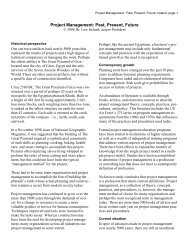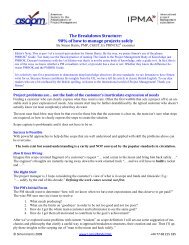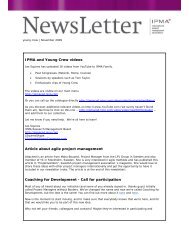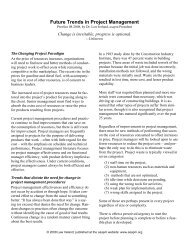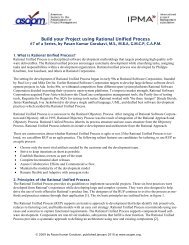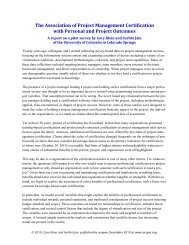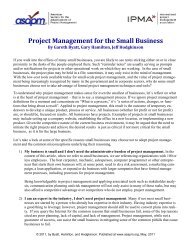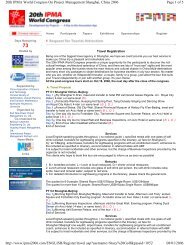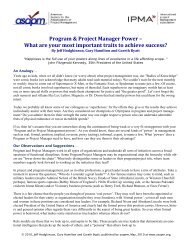Leading Successful PMOs - asapm
Leading Successful PMOs - asapm
Leading Successful PMOs - asapm
You also want an ePaper? Increase the reach of your titles
YUMPU automatically turns print PDFs into web optimized ePapers that Google loves.
<strong>Leading</strong> <strong>Successful</strong> <strong>PMOs</strong><br />
by Peter Taylor<br />
Editor’s Note: Rarely do we publish items with a promotional angle, but in<br />
the case of Peter Taylor, we make exceptions. This article highlights the publishing<br />
of Peter’s newest book; see the cover image at left. Thanks Peter!<br />
Many organizations profit hugely by utilizing a Project Management Office<br />
(PMO), it means they achieve benefits from standardizing and following project<br />
management policies, processes, and methods. However, building an effective<br />
PMO is a complex process; it requires clear vision and strong leadership<br />
so that, over time, it will become the source for guidance, documentation,<br />
and metrics related to the practices involved in managing and implementing<br />
projects.<br />
<strong>Leading</strong> <strong>Successful</strong> <strong>PMOs</strong> will guide all project based organisations, and project<br />
managers who contribute to and benefit from a PMO, towards maximising<br />
their project success. In it, Peter Taylor outlines the basics of setting up a PMO and clearly explains how<br />
to ensure it will do exactly what you need it to do - the right things, in the right way, in the right order, with<br />
the right team.<br />
With a foreword by Chris Walters, Chairman of the PMOSIG, where he states ‘Peter’s book breaks new<br />
ground in looking at the leadership of <strong>PMOs</strong>’ and ‘This book reflects on PMO leadership topics based on Peter’s<br />
extensive experience in inventing and reinventing PMO functions in fast moving organisations. If you<br />
need a PMO (which you do, if you deliver projects) and you really care about your business (which I also assume<br />
you do), then you need a strong PMO leader. Reading this book will give you a fantastic vision for the<br />
role and the person that would fill it’.<br />
The purpose of the PMO<br />
The Project Management Office (PMO) in a business or professional<br />
enterprise is the department or group that defines and maintains<br />
the standards of process, generally related to project management,<br />
within the organization.<br />
The PMO strives to introduce economies of repetition in the execution<br />
of projects.<br />
The PMO aims to reduce project risk through common practice<br />
and quality assurance.<br />
The PMO links business strategy to project based execution of that strategy.<br />
In a recent survey ‘The State of the PMO 2010 1 ’ research showed that 84% of companies now have a PMO<br />
(Project Management Office) in some form to support their project based activity.<br />
1 PM Solutions Research. (2010) The State of the PMO 2010. Research report. Glen Mills, PA: PM Solutions www.pmsolutions.com<br />
© 2011, by Peter Taylor Published at www.<strong>asapm</strong>.org, October, 2011
<strong>Leading</strong> <strong>Successful</strong> <strong>PMOs</strong>, by Peter Taylor; page 2<br />
According to Gartner Industry Research, ‘building a Project Management Office (PMO) is a timely competitive<br />
tactic’ - Further, they believe that "organizations, who establish standards for project management, including<br />
a PMO with suitable governance, will experience half the major project cost overruns, delays, and cancellations<br />
of those that fail to do so".<br />
What is a PMO?<br />
Project Management is all about doing something (a project) in the right way and the ‘right way’ is all about<br />
method and discipline and quality and control.<br />
Program Management is all about doing those things (the projects) in the right sequence or order.<br />
Portfolio Management is about doing the right things.<br />
Which leaves the PMO; and which you can think of as doing all the above but with the right team (the right<br />
things, in the right way, in the right order).<br />
Are all <strong>PMOs</strong> the same?<br />
A PMO can typically be one of six types from an organizational perspective:<br />
A Departmental PMO<br />
A special–purpose PMO<br />
An Outreaching (Supplier) PMO<br />
An External (Customer)PMO<br />
And a model of an Enterprise PMO (internal or external)<br />
There is one view that there are only three PMO types, enterprise, departmental and special-purpose but I believe<br />
that what is often forgotten are the organisations that reach outside with their <strong>PMOs</strong> to external customers<br />
to support project managers working alongside and managing customer led projects. If you are a service<br />
based company you will certainly recognise this flavour of the PMO. In addition there is the work that such<br />
<strong>PMOs</strong> can get involved in through advising and supporting customer centred <strong>PMOs</strong> – offering governance,<br />
guidance and resources.<br />
So I believe that there are in fact six types that need to be understood or at least appreciated.<br />
A way of looking at this is to consider ‘Internal’ <strong>PMOs</strong> – those <strong>PMOs</strong> that oversee projects that are sanctioned<br />
within an organization for self-improvement or compliance reasons - as one category.<br />
Then ‘External’ <strong>PMOs</strong> – those <strong>PMOs</strong> that exist to ensure that organisations’ customer projects deliver the return<br />
on investment expected – as a second category.<br />
A third category can be the ‘Special purpose’ <strong>PMOs</strong> created for specific situations or needs.<br />
Against these there is the scale of the PMO coverage from departmental or business unit level through to enterprise<br />
level.<br />
Internal <strong>PMOs</strong><br />
Let’s begin with perhaps the most common type of PMO; the internal to an organization PMO that is focused<br />
on projects primarily within that organization, for self-improvement or compliance purposes.<br />
And the most common variety will be the departmental PMO:<br />
© 2011, by Peter Taylor Published at www.<strong>asapm</strong>.org, October, 2011
<strong>Leading</strong> <strong>Successful</strong> <strong>PMOs</strong>, by Peter Taylor; page 3<br />
Departmental <strong>PMOs</strong>: Department based <strong>PMOs</strong> might be just a small group that manages very specific projects<br />
within their own landscape and with their own resources. Any projects that require resources outside this<br />
department may have difficulties securing and maintaining such resources. Moving up to the organizational<br />
level the bandwidth of resources and scope of projects is greater but the limitations may still be encountered.<br />
External <strong>PMOs</strong><br />
Now let’s consider those <strong>PMOs</strong> that are not internal to an organization as such but that focus on the outside<br />
customers of many service companies for example.<br />
Here we can describe the outreaching PMO.<br />
Outreaching (Supplier) PMO: Here the PMO’s role is to oversee project methodology and practice and<br />
standards for a community of project managers dealing with projects inside customer organizations – deploying<br />
solutions developed by their own company as a supplier to these external customers.<br />
External (Customer) PMO: As an extension of the service that outreaching <strong>PMOs</strong> may offer then they may<br />
also offer guidance and governance to these external customers on setting up and running their own <strong>PMOs</strong>.<br />
Now it is quite possible that an external PMO can also undertake internal project oversight and management,<br />
and equally that an internal PMO might undertake the occasional external or customer focused project activity.<br />
The internal and external tags indicate the primary focus of the project work.<br />
Enterprise <strong>PMOs</strong><br />
For both the internal and the external <strong>PMOs</strong> there can be large benefits in scaling up to an enterprise level.<br />
Enterprise Internal PMO: The next step for a PMO is for it to move up to the corporate level. This allows<br />
the PMO to gain a strategic position within the organization and to ensure that projects proceed based on<br />
their strategic alignment to the key business objectives of that organization. Such am enterprise PMO based<br />
is far more likely to gain executive support.<br />
Enterprise external PMO: The next step for an ‘Outreaching’ PMO is for it to move up to the corporate level.<br />
As in internal <strong>PMOs</strong> this allows the ‘Outreaching’ PMO to gain a strategic position within its own organization<br />
and offers to external customers a consistent project delivery and service model across the<br />
world.<br />
Special Purpose <strong>PMOs</strong><br />
And there may be a need in some cases for special <strong>PMOs</strong> created for a specific and discrete purpose.<br />
© 2011, by Peter Taylor Published at www.<strong>asapm</strong>.org, October, 2011
<strong>Leading</strong> <strong>Successful</strong> <strong>PMOs</strong>, by Peter Taylor; page 4<br />
Special-purpose PMO: What about the special–purpose PMO which may have been created for a single major<br />
project or set of projects, something that was critical to the business as it underwent a step change in its<br />
technology platform as one example. Here the special-purpose PMO may be departmental or enterprise focused<br />
and may be IT and/or business focused. It will, however, be created only for a special purpose and will,<br />
most likely, cease to exist once that purpose has been completed.<br />
Operational Mode<br />
So we have explored one dimension of the PMO; the internal or external focus of its work. Now let’s explore<br />
the second dimension if you will; that of operating method or approach.<br />
A PMO can operate in a number of ways:<br />
Supportive<br />
Controlling<br />
Directive<br />
Supportive<br />
The Supportive PMO is all about helping out project managers by providing some level of support in the form<br />
of project expertise, templates, guidelines, best practices (or at least proven practices), knowledge and project<br />
expertise, typically based on personal experience and/or a network of experienced people throughout the organisation.<br />
It can be seen as a process of bringing together of a project community, where before there has only been silos<br />
of project based activity and a lack of knowledge sharing.<br />
Why use a supporting model?<br />
The requirement is to merely aid the existing project activity to raise the levels of project success<br />
To share project management information across a wider group of project managers<br />
To empower the project managers and project teams to solve common problems and be more successful<br />
Controlling<br />
The Controlling PMO is applicable where there is a desire to have a stronger discipline on all project activities,<br />
methods, procedures, documentation etc.<br />
Why use a controlling model?<br />
To ensure that a standard and consistent methodology is used<br />
To ensure that regulatory compliance is adhered to<br />
Where there regular reviews that need to be passed<br />
A project or projects are high or higher risk than normal<br />
A project or projects are a high or higher profile than normal<br />
A new business endeavour<br />
Directive<br />
This Directive PMO goes beyond control and actually takes over the project or projects by providing the necessary<br />
project management experience and resources.<br />
Project managers from the PMO itself are assigned to each new project and reporting of project progress is direct<br />
to the PMO itself.<br />
© 2011, by Peter Taylor Published at www.<strong>asapm</strong>.org, October, 2011
<strong>Leading</strong> <strong>Successful</strong> <strong>PMOs</strong>, by Peter Taylor; page 5<br />
Why use a directive model?<br />
To guarantee the highest level of consistency of project management practice across all projects<br />
To reduce costs by centralizing project services<br />
To de-risk project delivery<br />
Blended<br />
There is in fact another way that <strong>PMOs</strong> can operate and that is a combination of the three. A mixture of directive,<br />
supporting and controlling or perhaps better described as a ‘blended’ approach. And the blend can be<br />
of any two modes or a combination of all three.<br />
This is a quite common PMO mechanism – being flexible depending upon the actual situation.<br />
And what does a PMO do?<br />
Finally, and just for completeness sake, let’s take a very quick look at what a PMO does (or could do).<br />
The short answer is ‘anything that the business wants it to do’ – especially if that PMO is in the period of<br />
proving value and the business in question has just made a significant investment in setting the PMO up.<br />
The longer answer could include:<br />
Project Management community of practice ownership or lead<br />
Methodology<br />
Training and Certification<br />
Resource Management<br />
Project (Program – Portfolio) Reporting<br />
Coaching, mentoring, support<br />
Business alignment<br />
Quality Control<br />
Financial follow up and support<br />
Project selection and/or decision making<br />
And many more besides these.<br />
© 2011, by Peter Taylor Published at www.<strong>asapm</strong>.org, October, 2011
<strong>Leading</strong> <strong>Successful</strong> <strong>PMOs</strong>, by Peter Taylor; page 6<br />
The point here is really that the PMO’s range of responsibilities can be simple or complex.<br />
Add to that the many forms of <strong>PMOs</strong> that can exist then it could be said that there is no one answer or solution<br />
to the project and business challenges that the PMO could be the answer for.<br />
The PMO Acid Test<br />
How successful is your own PMO? Take the 5 question PMO ‘acid’ test:<br />
Who<br />
‘Call up your CEO and then count the number of seconds before he recognizes your name...’ If your PMO is<br />
really connected to the business, at the right level and with the right profile, then your CEO will know you and<br />
your <strong>PMOs</strong> work.<br />
You don’t have to start with the CEO, you can try this out moving up the organisation level by level – who at<br />
two levels above you knows you and the <strong>PMOs</strong> work? For those that do say ‘thanks’ and for those that don’t;<br />
well tell them about it.<br />
What<br />
‘What happens when you call up a project manager do you get straight through or do they adopt an avoidance<br />
strategy...’ A call from any member of the PMO should be a welcome event and not something to hide from or<br />
fear.<br />
Consider if there are certain individuals or teams or departments that are resistant to what the PMO is trying to<br />
achieve. Ask yourself why this is and plan a charm offensive to demonstrate that the PMO is their friend.<br />
When<br />
‘When was the last time that a project manager contacted your PMO asking for some form of help? ...’ If this<br />
has not happened in some time then perhaps your PMO is not as accessible and open as you may wish it to be?<br />
Run a survey or open session to gain some insight in to the reasons for non-contact with the PMO. It may link<br />
to the ‘what’ question above i.e. fear of the PMO, or it may be just a lack of awareness. Go out of your way to<br />
help key people, regardless of if it isn’t really in your PMO remit – by winning influential supporters the word<br />
will spread about the PMO being a ‘go to’ group.<br />
Where<br />
‘Do people ask many times over where they should go for project information or project help...’ The PMO<br />
should be the automatic first call for anything project related when project managers or others need some<br />
guidance, make sure yours is easy to access and quick to respond.<br />
Market what the PMO does, create a menu of service items that the PMO can deliver ‘off the shelf’ and advertise<br />
this tirelessly.<br />
Why<br />
‘Do people ask why they should use the PMO and do they know what your PMO does...’ You should have<br />
marketed the value of your PMO throughout the organization and people should easily access a ‘service menu’<br />
or what the PMO can do to help them.<br />
Success stories really help here with proven benefits of PMO involvement, invest your time in developing<br />
some and get people outside the PMO to write them or at least validate them.<br />
© 2011, by Peter Taylor Published at www.<strong>asapm</strong>.org, October, 2011
<strong>Leading</strong> <strong>Successful</strong> <strong>PMOs</strong>, by Peter Taylor; page 7<br />
How<br />
And finally question number six – the ‘how’ – how can you improve the <strong>PMOs</strong>’ work and profile, its performance,<br />
its acceptance and its role in your company? How can you do this?<br />
You need to think and plan and act.<br />
About the Author<br />
Peter is a dynamic and commercially astute professional who<br />
has achieved notable success in Project Management.<br />
His background is in project management across three major<br />
business areas over the last 26 years, MRP/ERP systems with<br />
various software houses and culminating in his current role<br />
with Infor, Business Intelligence (BI) with Cognos, and product<br />
lifecycle management (PLM) with Siemens.<br />
He has spent the last 7 years leading <strong>PMOs</strong> and developing<br />
project managers and is now focusing on project based services<br />
development with Infor.<br />
He is also an accomplished communicator and leader and is a professional speaker as well as the author of<br />
‘The Lazy Project Manager’ (Infinite Ideas) and ‘<strong>Leading</strong> <strong>Successful</strong> <strong>PMOs</strong>’ (Gower) and ‘The Lazy Winner’<br />
(Infinite Ideas).<br />
More information can be found at www.leadingsuccessfulpmos.com – and through his free podcasts in<br />
iTunes.<br />
© 2011, by Peter Taylor Published at www.<strong>asapm</strong>.org, October, 2011





